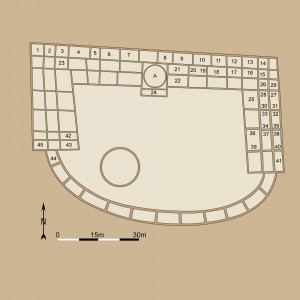Chaco Sites
Hungo Pavi
Site Description:
Hungo Pavi is an unexcavated great house located about 1.8 miles (2.9 km.) southeast of Pueblo Bonito at the mouth of Mockingbird Canyon. According to an 1849 ground plan created by Edward Kern, “Pueblo Hungo Pavie” was at that time translated as the “Crooked Nose Pueblo” – a Hopi translation (Linford 2000). Others suggest the name may have resulted from a mispronunciation or misspelling of the name for a Hopi village.
The site contains approximately 140 rooms. The north roomblock includes three rows of rooms and stood at least three-stories tall along the rear wall, dropping to a single story along the plaza. The structure is D-shaped with a single row of rooms enclosing the plaza. Two kivas have been identified; a central, elevated kiva within the north roomblock and a great kiva in the plaza. Construction occurred in two primary periods. The first between the late 900s and the early 1000s and included the two northern rows of rooms in the main roomblock. The second building episode is dated to the mid-11th century, and added the eastern and western wings, upper stories to the main roomblock, and the row of rooms on the south side that enclosed the plaza.is dated to the middle 1000s. Two tree-ring dates in the mid-10th century suggest the possibility of an earlier construction episode.
Chacoans carved a series of steps into the cliff face behind the great house.
Alternative site designations include Hungo Pavie, Hungopavie, and 29SJ1918.
Excavation History
- Unexcavated
Size and Dates
- Approximately 140 rooms, one elevated kiva, and one great kiva
- Tree ring dates: Constructed during the late 10th to early 11th centuries, with additions in the middle of the 11th century
Site and Room Data
- Aztec West Ruins
- Bc 50 - Tseh So
- Bc 51
- Bc 53 - Roberts' Site
- Bc 57
- Bc 58
- Bc 59
- Chetro Ketl
- Pueblo Bonito
- Pueblo del Arroyo
- Shabik'eshchee
- Talus Unit #1


